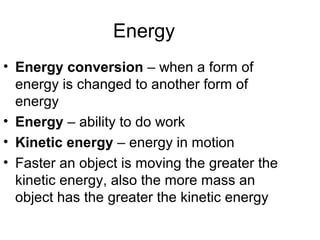
Energy
- 1. Energy • Energy conversion – when a form of energy is changed to another form of energy • Energy – ability to do work • Kinetic energy – energy in motion • Faster an object is moving the greater the kinetic energy, also the more mass an object has the greater the kinetic energy
- 2. • Potential – energy due to the objects position (object could move) • Gravitational potential energy – energy against the force of gravity—lifted objects have GPE • Mechanical energy – Has both kinetic + potential
- 3. • Law of conservation of energy – energy cannot be created or destroyed but can be changed from one form to another • Energy efficiency – the amount of useful energy after a conversion – the more efficient the more energy that can be used • Ex: shape of car, shape of plane, houses, windows
- 4. • Thermal energy – all the kinetic energy due to motion of particles that make up the object (faster the particles move the greater the thermal energy) • Chemical energy – energy of a compound that changes as its atoms are rearranged, a form of potential energy
- 5. • Electrical energy – energy of moving electrons, a form of potential energy since motion only happens when object is connected to actual output • Sound energy – vibrating object transmit energy through matter (S-L-G) • Light energy – vibration of electrically charged particles, doesn’t need to be carried through matter, can travel in a vacuum (area with no matter-- SPACE)
- 6. Alternative Energy Sources • Solar energy – energy from the sun, • Hydroelectric (water) – energy from falling/moving water • Wind energy – energy from the heating of earth surface • Geothermal – energy from the heating of earth’s core • Biomass – energy produced from plants, renewable
- 7. Energy resource Advantage Disadvantage Fossil Fuels (petroleum, Easy transport, large Nonrenewable, pollution, coal, natural gas) thermal energy per unit produces acid rain Nuclear Large amount of energy, Radioactive waste, no pollution elements are nonrenewable Solar Limitless, no pollution Expensive, practical only in sunny areas Hydroelectric Water is renewable, no Disrupts ecosystems, pollution only where moving water Wind Limitless, inexpensive, Only where wind blows no pollution consistently Geothermal Limitless, little land Practical in hot spots, required to build produces waste water Biomass Renewable Pollution, requires large farm land
- 8. • Nuclear energy – energy from the change in the nucleus of an atom • Nuclear fusion – the joining of atoms (H) • Ex: when hydrogen is fused together at very high speeds to form helium (stars are nuclear reactors on a massive scale), the process releases tremendous amounts of energy
- 9. • Nuclear fission – the splitting of an atom • Ex: when uranium is split, the potential energy in the nucleus is given off and used in nuclear power plants to generate electrical energy
- 12. • Electrical – can be changed into thermal, sound, light and kinetic energy (most common energy used) • Energy conversions allow us to maintain our daily lives through machines • Conversion of energy always creates a certain amount of thermal energy for the transition to take place
- 13. • Chemcial: • Photosynthesis – light energy to chemical energy • 6CO2 + 6H2O + light energy → C6H12O6 + 6O2 • Cellular respiration – humans turning food (chemicals) into energy • C6H12O6 + 6O2 → 6CO2 + 6H2O + ATP (energy)
- 14. • Nonrenewable resource – a resource that cannot be replaced in a reasonable amount of time • Fossil fuels – (contains chemical energy) – Coal – buried dead plants – Petroleum/natural gas - animals that were buried millions of years ago
- 15. • 3 most common types of fossil fuels are: – Coal – used to produce electrical energy by power plants – Petroleum – used to run cars and create other petrochemical products (plastics), Natural Gas – heat homes and buildings